 Oceanic Submersible (1927-41)
Oceanic Submersible (1927-41)WW2 Italian Submarines
Balilla class (1927) | Ettore Fieramosca (1929) | Archimede class (1933) | Glauco class (1935) | Pietro Micca (1935) | Calvi class (1935) | Foca class (1937) | Marcello class (1938) | Brin class (1939) | Liuzzi class (1939) | Marconi class (1940) | Cagni class (1940) | Romolo class (1943)Mameli class (1926) | Pisani class (1928) | Bandiera class (1929) | Squalo class (1930) | Bragadin class (1929) | Settembrini class (1930) | Argonauta class (1931) | Sirena class (1933) | Argo class (1936) | Perla class (1936) | Adua class (1936) | Acciaio class (1941) | Flutto class (1942)
CM class (1943) | CC class (Laid down) | CA class (1942) | CB class (1942)
Ettore Fieramosca was designed by Bernardis as a cruiser submarine capable initially to carry a seaplane in a waterproof hangar armed armed with a single 203 mm (8 in) gun, partly inspired by the French Surcouf under construction. The completed submarine was much smaller, and the prototype seaplanes tested were not impressive, so that they were never deployed and the hangar removed in 1931. Her inisial heavy gun was replaced in the final design by a more reasonable 120 mm/27 OTO modello 1924, and later by a 120 mm/45 modello 1931. Many estimated she was over-dimensioned for her armament. Trials showed also she was slower than intended, she never reached 20 knots and he size meant poor manoeuverability and even endurance which was an issue for her long range missions so she remained alone in her class and the Regia Marina never returned to this type, preferring venturing either in midget subs or large transport submarines. Her engines proved troublesome during in her career, and after a few war patrols in 1940 she suffered a battery explosion later that year, beings decommissioned by April 1941, then stricken and scrapped.
Design of the class
Italian submarine cruisers
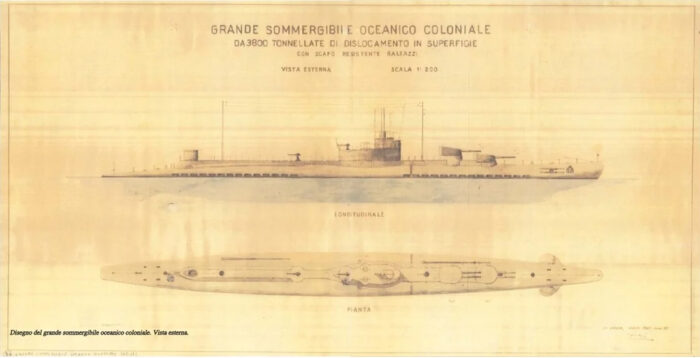
1929 Project of large oceanic colonial submersible. No aircraft, but four twin turrets.
In 1925, the Washington treaty’s absence of regulation on submarines (to the dismay of Britain) combined to the low tonnage agreed for the French and Italian Navy prompted the latter to have a go on cruiser submarines. The idea was to experiment on these, teste the concept, and if successful, create a whole class that could be later used in case of war, to severely disrupt enemy trade. The concept itself had been initiated by Germany in 1917 and the entente owned postwar some plans and blueprints for 3,000t, two 15 cm gun armed behemoths that were never completed. Britain itself tested the M class in 1917-18 and later the X1 was started in 1921 whereas the USN were starting their V series and soon unveiled the mighty USS Argonaut and the Narwhal class. But by that stage, the treaty of Washington had made the Marine Nationale and Regia Marina de facto rivals in the Mediterranean.
The French naval staff, bitter of loosing its expected tonnage to maintain a presence across the French empire, looked at submarines, the only category not yet regulated, to play a deterrence from distant stations. France also looked at the concept of a proper submarine cruiser to disrupt lines of communication and embarked on the construction of Surcouf, laid down at Cherbourg in July 1927 and planned to be the largest of her day, at 4000 tonnes submerged, with two 8-inches (203 mm) guns in a turret, and carrying an observation plane. On the other side of the world, Japan also started work on cruisers carrying reconnaissance seaplanes. In the Mediterranean, this type of submarine could cause havoc on Italian lines to Lybia and East Africa.
So as soon as the Surcouf construction and base characteristics were known, it was obvious that the Regia Marina had to put some reciprocity. Thus, Italy created its first cruiser submarine design (conways says it was the second), but the other ones often cited were the pair of Cagni class boats built in 1940 and a bit larger. The latest potential “cruisers” where the Micca class, which first boat, Pietro Micca was launched in 1917 at La Spezia and the rest in 1918-19, designed by Committee and in cooperation with Eg. Lt. Virginio Cavallini. The Micca had frequent breakdowns and poo manoeuvrability, so they were rebuilt in 1923 but were a starting base, at 1,244t fully loaded. They were eventually stricken in 1928-1938 (for Galvani).
Development
The submarines built by Italy before and during World War I were coastal units designed for the Adriatic Sea against Austria-Hungary. However the changing international situation in 1919 made it necessary to look for seagoing, long range models. From the arrival into power of Mussolini, boats capable of operating against the Marine Nationale and Royal Navy. The new armament program adopted in 1923–1924 was capped to 36,568 tons, based on which were built the heavy cruisers Trento and Trieste, Sauro and Turbine classes destroyers, and Balilla, Mameli and Pisani class submarines. Their design were created at the same time to compare characteristics and act as target types for the Italian submarine fleet, based on operational experience.
In 1925, the Regia Marina commissioned engineer Curio Bernardis to design a “large (cruiser) submarine to operate in the Red Sea and Indian Ocean. A single-hull design was adopted, with a very large conning tower that can house a covered platform for a 120 mm L/27 deck gun in its forward section, plus a hangar for a seaplane in its rear section. The designed speed was 19 knots surfaced, 10 knots underwater, with the installation of an external saddle ballast tanks to improve stability.
Construction and design changes
For this long range oceanic model, the Regia Marina decided to experiment with a larger hull compared to those of the “Balilla” class boats. In 1925 this new design was entrusted to General G.N. Bernardis. In 1926, the project was approved and construction of the prototype was ordered at Tosi shipyards, in Taranto. The novelty and continuous changes in technical specifications led to an extension of the construction between launch (1929) and acceptance in 1931, with two and a half years in between.
First off, this boat had a thicker pressure hull ending in truncated cones at both ends by semi-spherical caps. The amidship hull saw a double hull creating alongside a double bottom ample space for ballasts. The outer hull represented about two thirds of the length. It had two counter-keels. Part of the outer hull was taken by large fuel oil tanks. The outer hull ended on both ends by light structures containing the trimming ballast tanks.
The armament evolved considerably as initially it was envisioned no less than 203 mm or 8 inches guns however, this cause so much immalance and issues that was discarded before the final project was drawn up. The final main armament was down to 150 and then mors practicable 120 mm guns, and mines as well as torpedo tubes, with internal aft mine-launching tubes for 24 one ton models, and two external fixed watertight torpedo launchers, plus four internal bow torpedo launchers. The final artillery was shielded and its arrangement, recalled that of the Balilla class. What was maintained all along was a rear island watertight hangar aft of the turret for a small seaplane, the model of which needed to be looked after.
During construction, the armament was altered again. Before lauch, it was decided to eliminate the mine-launching tubes and two external torpedo tubes. In their place four internal aft torpedo launchers were installed. The main gun was also moved further forward and completely separated from the turret. The watertight hangar was also relocated further aft. It was eventually eliminated in 1931, before final completion and acceptance. This would be mainly due to no dedicated type of seaplane was suitable.
Fieramosca in the end was so downgraded in armament it looked oversized for its advantages. These various modifications adversely affected the initial project and the expected speed of 19, and later 20 knots was in reality never reached. The inert bulk was such that this submarine dive very slowly and when submerged or in surface, proved not maneuverable at all. Fieramosca in its life, would suffer numerous accidents on top of this all. Already after sea trials it was evident this was not a wining formula and the concept of cruiser submarine, at least in that shape, was not to be followed. No other of this class was ordered.
As built at the Cantieri navali Tosi di Taranto, Fieramsoca (after a famous Condotierri) had bee laid on 17 July 1926, launched on 15 April 1929, so three years later, for a completion in late 1930.
Hull and general design
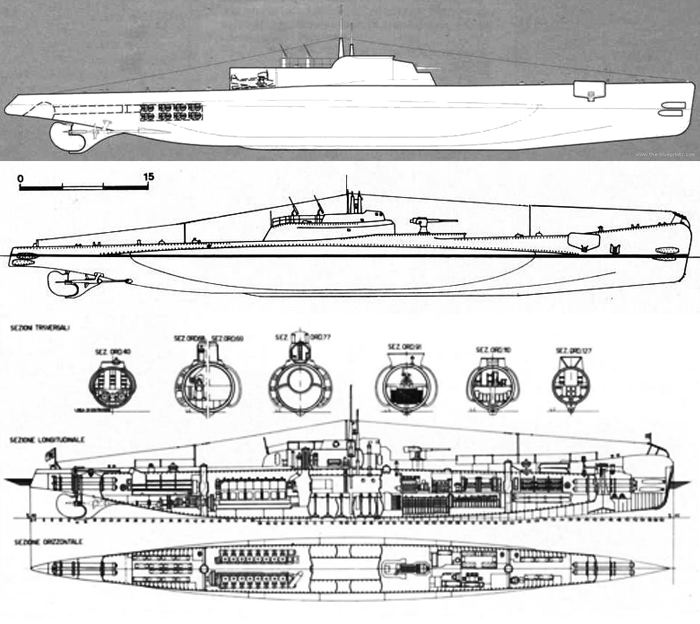
Ettore Fieramosca was of single-hull construction but with a double bottom and amidship outer hull ballasts. She was the largest Italian submarine so far at 84 meters, for 8.3 meters wide and with a draft of 5.11 meters. Normal displacement went up to 1,556 tons, and when submerged, 1,965 tons. Her crew consisted of 7 officers and 71 petty officers and sailors. In her initial appearance she was a very different animal. She had a continuous flush deck hull rising to amidship, then with a flatter angle to create a flat deck all the way to the bow.
The diving planes were located aft of the torpedo tubes and carried lifted up when surfaced. The island was massive, with a forward shielded 120 mm which had limited traverse, placed in en encased structure. The open bridge followed immediately after. Next aft to the main persicopes and masts was located a “winter garden”, a platform supporting two 12.2 mm Breda HMG AA mounts. Just aft of it was the watertight hangar containing a seaplane (see below).
Powerplant
Ettore Fieramosca to reach her desired speed had the largest powerplant ever designed for an Italian submarine. When running surfaced she had two Tosi diesel engines rated for 2,600 bhp each, 5,200 combined mated on the two drive shafts. She also had an auxiliary diesel engine rated for 325 hp used to reload the batteries. Underwater propulsion counted on the Marelli electric engines with a combind output of 2,000 hp.
When trialled, the expercted 19-20 knots was down to a realistic 15 knots surfaced, and 8 knots submerged instead of 10 knots. The final range was less than expected at 5,300 nautical miles when cruising at 8 knots surfaced. It was down 1,600 nautical miles at 15 knots, in the hypothesis her seaplane would locate a convoy to catch up. This was down to 90 nautical miles at 3 knots when submerged and just 7 nautical miles at max speed of 8 knots. Her fuel tanks comprised 150 tons of diesel oil. Her operational depth was 100 meters, not a lot given her bulk and the clear visibility of Mediterranean waters in coastal areas. Her prpowerplant proved very troublesome and she had many problems while in service.
Armament
Etorre Fieramosca had eight fixed 533 mm torpedo tubes, all internal, four in the bow, four in the stern, with 14 torpedoes, which was not a lot for her size. The artillery changed a lot, and when the conning tower shielded gun was abandoned, the initial 120 mm L/27 deck gun was relocated forward on deck, just to be removed a newer 120 mm L/45 gun replaced it.
The single final 120 mm OTO M1931 L/45 deck gun was placed on a reworked deck walkway sponsoned over th hull to procure enough crew space around. The two rear AA Heavy Machine Guns were kept but the initial aft mine tubes were eliminated.
Main: 120mm/50 OTO Modello 1931
It weighed 3.2 tons, with a barrel elevation of -4° to 32° or 35° on later models. It fire a 22 kg (48.5 ibs) unitary HE shell or 23.15 kgs (51 ibs) AP rounds, which initial muzzle velocity was 730 m/s, range 14,000–14,500 meters at maximum elevation. Its rate of fire was 8 rounds/minute. It used a horizontal sliding block and was common to the Balilla, Fieramosca, Micca and Calvi Classes, so large oceanic submarines.
AA: 2x Breda Modello 31

The anti-aircraft defence counted on two twin Breda M1931 13.2 mm L/76 heavy machine guns, placed on rea platform of the conning tower. Each mount weighed 695 kg, but ensired an elevation of -10° to 90°. They fired 125 g unitary rounds, with a muzzle velocity of 790 m/s, maximum range of 6,000 meters and effective range of 2,000 meters. Their rate of fire was 500 rounds/min, so 2000 rounds when both twin mounts fired in concert however.
533 mm torpedoes
Model unknown. When completed it had likely Silurificio Whitehead di Fiume common A140/450 (1921). Capable of 29-32 knots, 6,000-4,000 m range settings, 1,140 Kgs, TNT warhead 140 kg, air tank loaded to 170 atmospheres. It was however quite visible due to the compressed air bubble trail, especially in calm waters.
Later in 1933-36 it was probably given more palatable models, all with wet-heaters:
-W 270/533.4 x 7.2 Veloce: 1,700 kg, 7.2 m WH 270 kg, 3,000-4,000 m/50 knots or 12,000 m/30 knots.
-W 270/533.4 x 7.2 “F”: 1,550 kg, 6.500 m, WH 250 kg, speed 3,000 m/43 knots or 10,000 m/28 knots
-W 250/533.4 x 6.5: 1,550 kg, 7.200 m, WH 270 kg, 4,000 m/48 knots or 12,000 m/30 knots.
-Si 270/533.4 x 7.2 “I”: 1,700 kg, 7.2 m, WH 270 kg, speed 3 km/42 kts or 7 km/32 kts, 9,2km/30 knots, 12km/26 kts
-W 250/533.4 x 6.72: 7.2m, WH 270 kg speed 4km/49 kts or 8km/38 kts.
-Si 270/533.4 x 7.2 “M”: 1,7 ton, 7.2 m, WH 270 kg speed 4km/46 kts, 8km/35 kts or 12km/29 kts.
It should be noted that Etorre Fieramosca was also given a pair of hydrophones.
Seaplane
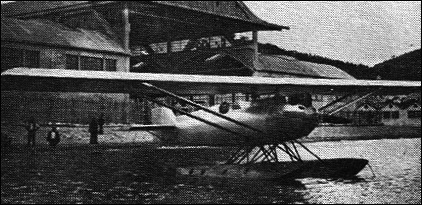
Having a seaplane small enough to be stowed dismounted inside the hangar and operated without a catapult was a problem of itself and several aicraft manufacturers in Italy proposed designs in 1928. In the end, one, Piaggio, was retained. The P.8 was specifically tailored to meet this Regia Marina requirement for Ettore Fieramosca, a model that can be stowed disassembled in a cylinder. To minimize danger to the submarine and aircraft during flight operations, the submarine needed to loiter on the surface while the aircraft was assembled or disassembled. It much be both quickly for flight operations and after recovery for stowage, lest the submarine, which also was slow to dive, could not be caught red handed by a distant ship or aircraft. Its sole purpose was reconnaissance, although initially when the project had its 203 mm guns, as a spotter. For a cruiser its role was to scout ahead in search of targets for the submarine, ideally a convoy.
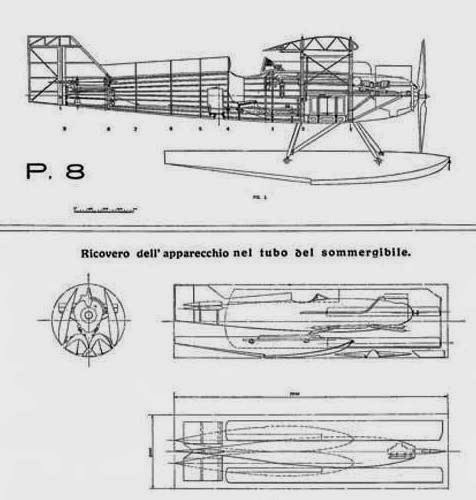
The P.8 first flew in 1928. It was a single-seat monoplane, with twin floats mounted beneath the fuselage and with a parasol wing. It had a 75 hp (45 Kw) Blackburn Cirrus II engine driving a two-bladed propeller for a modest top speed of 135 kilometers per hour or 84 miles per hour. It looked less flimsy and was faster still thn the Surcouf’s puny Besson, also a monoplane.
The P.8 was never tested in its hangar when Fieramosca was commissioned in 1930. Indeed plans changed, and none were deployed aboard. The hangar was simply removed in 1931. The single prototype faded later into obscurity. It seems she was planned also to operate a Macchi M.53.

Comparison between the Fieramosca and Pisani
⚙ specifications |
|
| Displacement | 1,530 tons surfaceed, 2,094 tons submerged |
| Dimensions | 83.97 x 8.30 x 5.11m (275.5 ft x 27.2 ft x 16.8 ft) |
| Propulsion | 2 shafts 5,200 bhp Tosi diesels, 2x 2300 shp CGE electric motors |
| Speed | 15 knots (28 km/h; 17 mph) surfaced, 8 knots (15 km/h; 9.2 mph) submerged |
| Range | 5,000 nmi/9 knots surfaced, 70? nmi/4 knots submerged |
| Armament | 1x 120 mm/50 (5 in) deck gun, 2× 13.2 mm AA MG, 8× 533 mm TTs (4 bow, 4 stern, 14) |
| Aircraft | 1 seaplane, tested, not operated. Hangar removed 1931. |
| Test depth | 100 m (330 ft) |
| Crew | 78 |
Career of Ettore Fieramosca
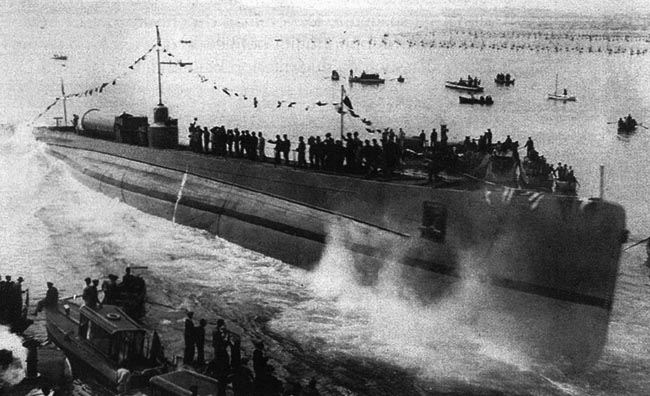
Launched, from secretproject.org (src below)
Ettore Fieramosca was commissioned on 5 December 1931 and started service in the Mediterranean 1st Squadron (Squadriglia), 1st Submarine Flotilla (Gruppo), La Spezia from 1932. In 1931 at completion her hangar was removed and the crew passed all training qualifications in the spring. Nothing of note in 1933-34 apart training manoeuvers with her unit in home waters. In 1935 she was transferred to the 2nd Squadron, 1st Submarine Flotilla.
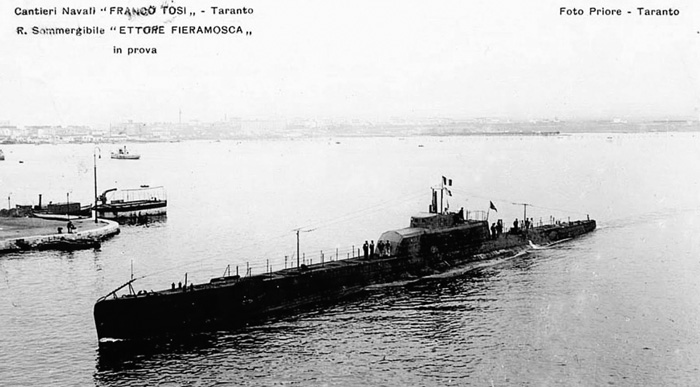
Postcard of Taranto showing Fieramosca just being completed in 1930, with her forward encased main gun (Marcello Risolo, secretproject.org)
The Spanish Civil War saw her first active deployment outside Italy, as part of the 2nd Submarine Flotilla based in Naples. She made two “combat” sorties on the behalf of the Nationalists as she was to spot and sink Republican vessels, notably those carrying ammunitions on the east coast. She operated under command of capitano di corvetta 2nd rank Mario Bartalesi. On December 21, 1936, she left Livorno for her first mission, heading for Valencia. On December 27, she spotted and fired three torpedoes at the Republican cruiser Méndez Núñez, but missed. On January 5, 1937, she was back to La Spezia. On January 28, she sailed for her second patrol, but soon returned due to a breakdown. After repairs, she sailed again on February 2, for Barcelona. She spotted no target at sea but on February 8 and 9, she shelled the port, spend about 35 120 mm shells, and she was back to La Spezia on February 16. Later she made tow more sorties, to Tunis and to Barcelona, the latter in 1939.
On 10 June 1940, Ettore Fieramosca was part of the 11th submarine squadron, 1st Flotilla, in La Spezia with Pietro Calvi, Giuseppe Finzi and Enrico Tazzoli, all three improved Balilla boats faster and better armed (comp. 1936). Whenthe war started she was commanded by 2nd Lt. Cdr. Giuseppe Mellina. Just beforte the declaration of war on France, Ettore Fieramosca was preventively sent on the approach to the Gulf of Genoa as a defensive measure. She was no alone, the RN sent also for a similar mission in pre-posisitioned areas Sebastiano Veniero, Gondar, Neghelli, Lazzaro Mocenigo and hour H clas boats. During a second mission her tactical assignments changed, she was to prey on French vessels making a sortie to North Africa in order to escort troopships back to France and patrol long the French shores in search of targets of oportunity. On 19–25 June she cruised off Hyères when her battery exploded. She had to return to La Spezia for long repairs and the war with France ended in between. The explosion was likely due to seawater infiltration and caused 10 crew unjuries but fatalities. Whe repaired she returned int service under 2nd Lt. Cdr. Beppino Manca.
On 15 October 1940, Ettore Fieramosca was judged too temperamental for frontline operations and she transferred to the Submarine School in Pola, under command of 2nd Lt. Commander Cristiano Masi. By March 1941, she had performed 28 short training cruises after which she was disarmed and decommissioned on 10 April 1941. There were far better, newly built submarines that needed experienced crews. She was mothballed until 1945 and stricken from the navy list, scrapped after 18 October 1946.
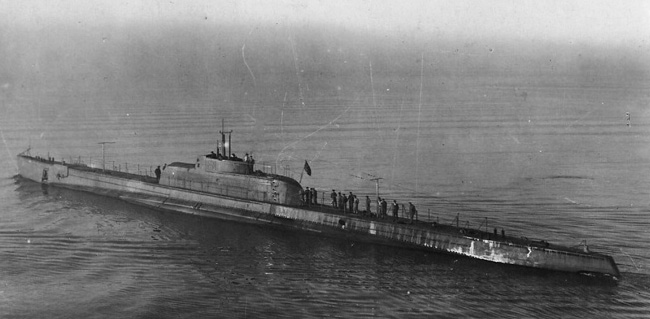
Fieramosca underway in the 1930s – Giuseppe Peluso, Betasom via secretproject.org.
Fieramosca overall was not a successful submarine. The very concept of submarine cruiser, beside italy, looked like a good idea on paper only. Most boats built as such were afflicted by many problems, often of performances and powerplants. Surcouf herself was quite impressive but suffered her load of issues. X1 was considered quite mediocre and had a limited, short-lived career, as were USS Argonaut and the two Narwhal, after changes made in propulsion. They were white elephants that never fit their intended role. Fieramosca in particular ended under-armed for her large size, high consumption. Neither her speed and range made her valuable as a commerce raider, she was under-armed (the Calvi class for example had two main guns and more torpedoes, the Cagni class even had 36 torpedoes and were successful commerce raiders at least in concept). She also had her load of issues with her intested powerplant.
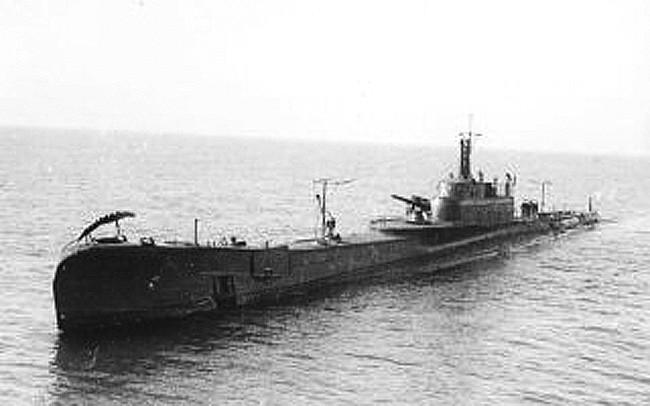
Official CC photo of Fieramosca
She soon in service earned the nickname “Fieroguaio” for her continuous breakdowns, including her battery explosion devastating rooms and caused many injuries, added to poor stability both surfaced and submerged as well as her poor maneuverability. Between 1936 and 1937 her clandestine Spanish Civil War campaign saw her completing only two missions for a total of 32 days, with 12 recorded attacks but no kills. On 27 December 1936 she had her most valuable target ever, in the cruiser Méndez Núñez proceeding with escort of two destroyers, but failed. On 8-9 February 1937 she shelled unchallenged the port of Barcelona, causing only light damage to the tanker Zorrosa (4600 GRT).
Due to the short time Italy was at war with France, she only completed one main mission on the coast of France, returning the first time to La Spezia on 14 June without spotting any target. Her second mission between 19 and 25 June was cut short by a battery explosion that nailed the coffin for any further operations.
Her assignement to training from 15 October 1940 in the newly created school of Pola was judged more valuable to RN service, but her general poor condition had her eventually retired after 28 training missions in early 1941. For WW2 in all she performed 31 missions.
Read More/Src

Books
Conway’s all the world’s fighting ships 1922-46
Giorgio Giorgerini, Uomini sul fondo. Storia del sommergibilismo italiano dalle origini a oggi.
rminio Bagnasco, Maurizio Brescia, I sommergibili italiani 1940-1943. 2013.
Maurizio Brescia e Sandro Bocchino, Giovanni Marabotto, in Storia Militare, n. 207, dicembre 2010.
Giorgio Giorgerini, Uomini sul fondo. Storia del sommergibilismo italiano dalle origini a oggi, Mondadori, 2002,
Links
https://www.betasom.it/forum/index.php?/topic/31953-classe-fieramosca-1926/
https://en.wikipedia.org/wiki/Italian_submarine_Ettore_Fieramosca
https://www.navypedia.org/ships/italy/it_ss_fieramosca.htm
https://www.worldnavalships.com/etorre_fieramosca.htm
https://alchetron.com/Italian-submarine-Ettore-Fieramosca
http://www.navweaps.com/Weapons/WTIT_List.php
http://www.navweaps.com/Weapons/WNIT_47-45_m1931.php
https://uboat.net/italian_submarines/classes/?id=2
https://www.betasom.it/forum/index.php?/topic/46832-sommergibile-oceanico-coloniale/
https://it.wikipedia.org/wiki/Ettore_Fieramosca_(sommergibile)
https://www.secretprojects.co.uk/threads/ettore-fieramosca-og-design.35087/
Model Kits
None

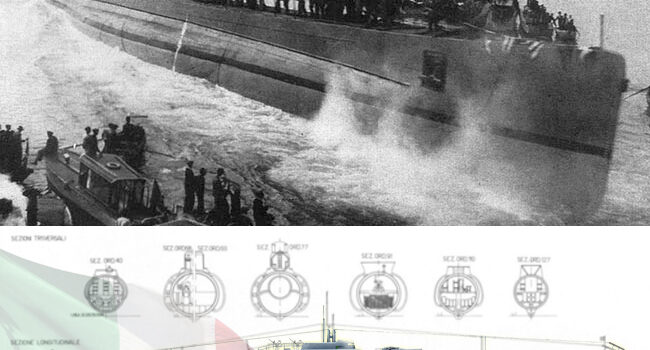
 Latest Facebook Entry -
Latest Facebook Entry -  X(Tweeter) Naval Encyclopedia's deck archive
X(Tweeter) Naval Encyclopedia's deck archive Instagram (@navalencyc)
Instagram (@navalencyc)





 French Navy
French Navy Royal Navy
Royal Navy Russian Navy
Russian Navy Armada Espanola
Armada Espanola Austrian Navy
Austrian Navy K.u.K. Kriegsmarine
K.u.K. Kriegsmarine Dansk Marine
Dansk Marine Nautiko Hellenon
Nautiko Hellenon Koninklije Marine 1870
Koninklije Marine 1870 Marinha do Brasil
Marinha do Brasil Osmanlı Donanması
Osmanlı Donanması Marina Do Peru
Marina Do Peru Marinha do Portugal
Marinha do Portugal Regia Marina 1870
Regia Marina 1870 Nihhon Kaigun 1870
Nihhon Kaigun 1870 Preußische Marine 1870
Preußische Marine 1870 Russkiy Flot 1870
Russkiy Flot 1870 Svenska marinen
Svenska marinen Søværnet
Søværnet Union Navy
Union Navy Confederate Navy
Confederate Navy Armada de Argentina
Armada de Argentina Imperial Chinese Navy
Imperial Chinese Navy Marinha do Portugal
Marinha do Portugal Mexico
Mexico Kaiserliche Marine
Kaiserliche Marine 1898 US Navy
1898 US Navy Sovietskiy Flot
Sovietskiy Flot Royal Canadian Navy
Royal Canadian Navy Royal Australian Navy
Royal Australian Navy RNZN Fleet
RNZN Fleet Chinese Navy 1937
Chinese Navy 1937 Kriegsmarine
Kriegsmarine Chilean Navy
Chilean Navy Danish Navy
Danish Navy Finnish Navy
Finnish Navy Hellenic Navy
Hellenic Navy Polish Navy
Polish Navy Romanian Navy
Romanian Navy Turkish Navy
Turkish Navy Royal Yugoslav Navy
Royal Yugoslav Navy Royal Thai Navy
Royal Thai Navy Minor Navies
Minor Navies Albania
Albania Austria
Austria Belgium
Belgium Columbia
Columbia Costa Rica
Costa Rica Cuba
Cuba Czechoslovakia
Czechoslovakia Dominican Republic
Dominican Republic Haiti
Haiti Hungary
Hungary Honduras
Honduras Estonia
Estonia Iceland
Iceland Eire
Eire Equador
Equador Iran
Iran Iraq
Iraq Latvia
Latvia Liberia
Liberia Lithuania
Lithuania Mandchukuo
Mandchukuo Morocco
Morocco Nicaragua
Nicaragua Persia
Persia San Salvador
San Salvador Sarawak
Sarawak Uruguay
Uruguay Venezuela
Venezuela Zanzibar
Zanzibar Warsaw Pact Navies
Warsaw Pact Navies Bulgaria
Bulgaria Hungary
Hungary

 Bundesmarine
Bundesmarine Dutch Navy
Dutch Navy Hellenic Navy
Hellenic Navy Marina Militare
Marina Militare Yugoslav Navy
Yugoslav Navy Chinese Navy
Chinese Navy Indian Navy
Indian Navy Indonesian Navy
Indonesian Navy JMSDF
JMSDF North Korean Navy
North Korean Navy Pakistani Navy
Pakistani Navy Philippines Navy
Philippines Navy ROKN
ROKN Rep. of Singapore Navy
Rep. of Singapore Navy Taiwanese Navy
Taiwanese Navy IDF Navy
IDF Navy Saudi Navy
Saudi Navy Royal New Zealand Navy
Royal New Zealand Navy Egyptian Navy
Egyptian Navy South African Navy
South African Navy






























 Ukrainian Navy
Ukrainian Navy dbodesign
dbodesign